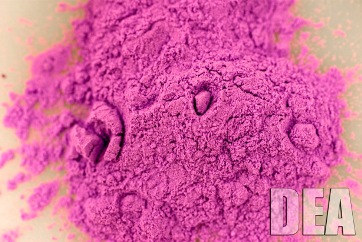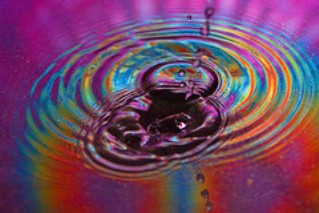Let's Take a Trip (LSD)
HISTORY OF LSD
LSD, or Lysergic acid diethylamide, as you may have guessed,
comes from the ergot fungus. It was first synthesized by the
Swiss chemist, Albert Hofmann in 1938 when he was doing research
on the fungus for medicinal purposes. He writes about his
experiences in his book, LSD: My Problem
Child, where he says: "Last Friday,
 April 16, 1943, I was
forced to interrupt my work in the laboratory in the middle of the afternoon and proceed home, being affected by a remarkable
restlessness, combined with a slight dizziness. At home I lay
down and sank into a not unpleasant intoxicated-like condition,
characterized by an extremely stimulated imagination. In a
dreamlike state, with eyes closed (I found daylight to be
unpleasantly glaring), I perceived an uninterrupted stream of
fantastic pictures, extraordinary shapes with intense,
kaleidoscope play of colors. After some two hours, this
condition faded away." Later in 1948, LSD was introduced
to the medical world as a psychiatric cure-all drug and it was
prescribed extensively. Production was halted in 1965, however,
because it was
April 16, 1943, I was
forced to interrupt my work in the laboratory in the middle of the afternoon and proceed home, being affected by a remarkable
restlessness, combined with a slight dizziness. At home I lay
down and sank into a not unpleasant intoxicated-like condition,
characterized by an extremely stimulated imagination. In a
dreamlike state, with eyes closed (I found daylight to be
unpleasantly glaring), I perceived an uninterrupted stream of
fantastic pictures, extraordinary shapes with intense,
kaleidoscope play of colors. After some two hours, this
condition faded away." Later in 1948, LSD was introduced
to the medical world as a psychiatric cure-all drug and it was
prescribed extensively. Production was halted in 1965, however,
because it was growing too popular and there was a lack of
positive long term effects and they were actually finding a lot
of adverse side effects, like flashbacks and terrors. Even
though the use of LSD in the medical community for
medicinal
purposes was declining, history tells us that LSD was still very
popular in the 1960s. One
man that you have probably already
heard of is Dr. Timothy Leary. Dr. Leary was a professor at
Harvard University and was pro-LSD. He was giving it to students
and
running experiments on prisoners, which he claimed resulted
in a 90% success rate in preventing repeat criminal offenses. Then his
students began to take it recreationally and Leary later told
Playboy Magazine that LSD was a potent aphrodisiac, something
that got him expelled from the university. Shortly after this,
President
Nixon claimed that he was the "most dangerous man in
the U.S." Leary did not stop there. In order to combat the
extensive anti-LSD propaganda being issued by the government, he
coined the phrase, "Turn on. Tune in. Drop out.", short for
turn on your mind, tune in to what you believe, and drop out of
the things you're not happy about. That's exactly what you want
your children hearing!
growing too popular and there was a lack of
positive long term effects and they were actually finding a lot
of adverse side effects, like flashbacks and terrors. Even
though the use of LSD in the medical community for
medicinal
purposes was declining, history tells us that LSD was still very
popular in the 1960s. One
man that you have probably already
heard of is Dr. Timothy Leary. Dr. Leary was a professor at
Harvard University and was pro-LSD. He was giving it to students
and
running experiments on prisoners, which he claimed resulted
in a 90% success rate in preventing repeat criminal offenses. Then his
students began to take it recreationally and Leary later told
Playboy Magazine that LSD was a potent aphrodisiac, something
that got him expelled from the university. Shortly after this,
President
Nixon claimed that he was the "most dangerous man in
the U.S." Leary did not stop there. In order to combat the
extensive anti-LSD propaganda being issued by the government, he
coined the phrase, "Turn on. Tune in. Drop out.", short for
turn on your mind, tune in to what you believe, and drop out of
the things you're not happy about. That's exactly what you want
your children hearing!
LSD AND THE CIA
Yes, you read that right. The CIA used and experimented on LSD! It
was there top -secret mission, MK-ULTRA through which they were
hoping to find a mind controlling agent. They were looking to use it
as a form of psychological torture and they ran tests on members of
the general public and CIA agents, often without their knowledge or
consent. Many of the people that were involved in this experiment
underwent such a sever trauma that many either committed suicide or
wound up in a psychiatric ward. The researchers of this drug
eventually realized that LSD was WAY too unpredictable to be used
effectively. There is also a theory that the CIA covertly
advocated for the use of LSD in the American youth in the 60's as a
way to undermine the growing anti-war movement and emerging
counterculture. Hmm, interesting!
-secret mission, MK-ULTRA through which they were
hoping to find a mind controlling agent. They were looking to use it
as a form of psychological torture and they ran tests on members of
the general public and CIA agents, often without their knowledge or
consent. Many of the people that were involved in this experiment
underwent such a sever trauma that many either committed suicide or
wound up in a psychiatric ward. The researchers of this drug
eventually realized that LSD was WAY too unpredictable to be used
effectively. There is also a theory that the CIA covertly
advocated for the use of LSD in the American youth in the 60's as a
way to undermine the growing anti-war movement and emerging
counterculture. Hmm, interesting!
LSD AND POPULAR CULTURE
Many believe that much of the great music produced by the Beatles
was a result of taking some trips down LSD lane. In particular, the
song "Lucy in the Sky with Diamonds" primarily written by John
Lennon, is believed to be the offspring of LSD. Plus, the initials
of the song are LSD, which I thought was a little ironic. Check out
a video of this song below! Other
bands, such as Grateful Dead helped give birth to the terms
psychedelic or acid rock. LSD was very popular with the rebellious
youth of the 60's and continues to be popular among college and high
school age students. This is most likely because it only requires a
small amount of LSD to send you on a trip and it is easy to make.
HOW DOES IT WORK AND WHAT ARE THE SIDE EFFECTS?
Side effects of LSD are mainly due to the fact that LSD is similar
to serotonin, which regulates memory, anxiety, mood, aggression,
learning and sleep. LSD is the most potent naturally occurring
hallucinogen and is considered a "clean drug." This is because it
only stays in the body for 30 hours and is not addictive. But what
does it make you feel like? The mental side effects for LSD are
pretty variable and dependent on one's personality, mood,
expectations and surroundings. Many times, however, people report
seeing, hearing and touching things that don't exist, which makes
sense because LSD is a powerful hallucinogen. People also report an
altered sense of time, mixing of senses, distortion of space,
strange body sensations and changed and intensified thoughts. The
physical effects include dilated pupils, higher body temperature,
increased heart rate and blood pressure, sweating, loss of appetite,
sleeplessness, dry mouth and tremors. Another fun fact; the term
psychedelic was coined to describe the effects of LSD!
is because it
only stays in the body for 30 hours and is not addictive. But what
does it make you feel like? The mental side effects for LSD are
pretty variable and dependent on one's personality, mood,
expectations and surroundings. Many times, however, people report
seeing, hearing and touching things that don't exist, which makes
sense because LSD is a powerful hallucinogen. People also report an
altered sense of time, mixing of senses, distortion of space,
strange body sensations and changed and intensified thoughts. The
physical effects include dilated pupils, higher body temperature,
increased heart rate and blood pressure, sweating, loss of appetite,
sleeplessness, dry mouth and tremors. Another fun fact; the term
psychedelic was coined to describe the effects of LSD!
For more information make sure to check out this
website!
To learn how this fungus has impacted people for ages, check out the DISEASES/HISTORY page! Or go HOME.